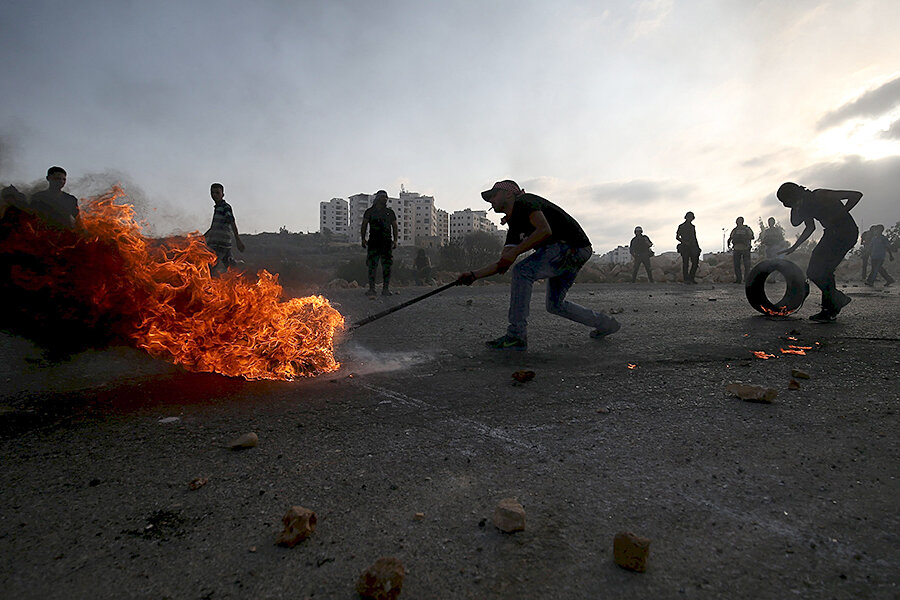Spike in Israeli-Palestinian violence. Is it a new uprising?
Loading...
| Tel Aviv
Are Israelis and Palestinians on the doorstep of a new intifada?
A spate of fatal attacks on Israelis and deadly West Bank clashes between Israeli security forces and Palestinian demonstrators have some asking whether the flare up in violence could signal the start of the first Palestinian uprising in 15 years.
The violence erupted amid already-high tensions over access to Jerusalem’s holy sites, while Palestinians are increasingly dismissive of leaders who have failed to deliver tangible progress on statehood.
But if both Israeli and Palestinians leaders are under pressure to broadcast an image of toughness, analysts note that the latest tensions do follow about a decade of cooperation between both sides’ security services that has helped tamp down intermittent flareups.
The latest escalation started Thursday night with a shooting attack near the northern West Bank city of Nablus in which an Israeli settler couple were killed while driving with their four children. About 48 hours later, on Saturday night, a knife-wielding Palestinian stabbed a group of Jews in the Old City of Jerusalem, killing two before being killed himself.
The two attacks book-ended a weekend in which hundreds of vigilante Jewish settlers around the West Bank attacked Palestinian villagers with stones, boulders, and burning tires.
On Sunday and Monday, as Israel imposed an unprecedented ban on Palestinian Jerusalemites from entering the Old City, riots erupted throughout the West Bank and in Arab sections of East Jerusalem, reportedly leaving three Palestinians dead.
“At this point, it is clear we are standing on a slippery slope,’’ wrote Amos Harel, the military correspondent for the newspaper Haaretz. He warned that additional deadly attacks could “release violent energies that the two sides have generally managed to remain on a low flame over the last decade.”
The violence comes amid a cold war between the Israeli and Palestinian governments that could contribute to a further escalation.
With peace negotiations in the deep freeze, Palestinian Authority President Mahmoud Abbas declared last Tuesday at the United Nations that he no longer sees himself bound by past peace accords with the Israelis. He has yet to condemn the recent killings. For his part, Israeli Prime Minister Benjamin Netanyahu has vowed to demolish the homes of Palestinian attackers and accused Mr. Abbas of quietly endorsing the violence.
Control of holy places
Further complicating the situation is a renewed debate over control of the holy places in East Jerusalem. Palestinian accuses Israel of trying to tighten control over the mosques in the Old City.
Both leaders are under pressure from outraged publics and political rivals.
Mr. Netanyahu, who heads a coalition government, has been attacked by Education Minister Naftali Bennett for an allegedly weak response to the violence. On Tuesday he will face a demonstration of Israeli right-wingers and settlers, and a prominent member of his own Likud party, Deputy Foreign Minister Tzippi Hotovely, is attending.
“Bibi is trying to look tough. But what can he do? There isn’t a lot to be done” against attacks carried out by Palestinian individuals, says Amir Tibon, the diplomatic correspondent for Walla!, an Israeli news website.
“Both Abbas and Bibi are concerned about their internal politics. Bibi is worried about the right wing, Abbas is worried about [Fatah rival Mohammed] Dahlan and Hamas looking for him around the corner.”
Indeed, analysts caution that 2015 isn’t the early 2000s, when the second Palestinian intifada erupted following the breakdown of peace talks. Back then, the West Bank was shot through with militant networks that had the arms and volunteers to carry out a string of bombings.
Another key difference is the rise of an effective Palestinian security force committed to keeping a lid on West Bank unrest in coordination with the Israeli army – a cooperation that persists despite the mutual accusations by the politicians. Some Palestinian officials have threatened to end this cooperation.
“The question of continuing or stopping this wave depends on whether there is meaningful coordination between the sides or not,” says Ghassan Khatib, a former spokesman for the Palestinian government.
But, he cautions, more deaths could push the violence to spiral beyond the control of political considerations.








